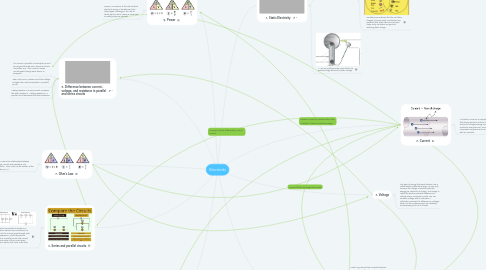
1. 5. Difference between alternating current and direct current
1.1. A direct current is an electric current supplied from an electric cell that flows in a singe direction. Battery-operated watches and devices use direct current. Alternating current is where the electrons periodically reverse direction. Wall outlets and AC circuits are examples of things that use alternating currents.
2. 6. Series and parallel circuits
2.1. Circuits can be connected in series or in parallel. When devices are connected in a series circuit, the current goes through each device in sequence. When devices are connected in a parallel circuit, the current splits up and some of the current goes through each device but never more then one.
2.1.1. Some devices have to be connected in parallel to others, like a voltmeter. Cells that are connected in parallel provide a given charge for a longer time or a greater current. Cells that are connected in series give a higher voltage.
3. 7. Ohm's Law
3.1. Ohm's Law is the relationship between voltage, current and resistance of a conductor. Ohm's law can be written as the equation R=V/I .
4. 8. Difference between current, voltage, and resistance in parallel and series circuits
4.1. The current in parallel circuits splits up and some goes through each device but never more than one. The current in series circuits goes through each device in sequence.
4.2. When cells are in a series circuit the voltage in higher than cells connected in a parallel circuit.
4.3. Adding resistors in a series circuit increases the total resistance. Adding resistors in a parallel circuit decreases the total resistance.
5. 9. Power
5.1. Power is a measure of the rate at which electrical energy is transformed into other types of energy or the rate at which work is done. Power is measured in watts (joules per second).
6. 1. Static Electricity
6.1. Static charge is electrical charge that is collected in one place. It is often encountered in everyday life when objects rub against one another and transfer charge. This is called friction. Charging by friction is when objects rub against each other and transfer electrons. Solid materials become charged due to the movement of electrons: electrons gained = negative charge, electrons lost = positive charge. This is because electrons are negatively charged.
6.1.1. The laws of static charge are that: like charges repel, opposite charges attract and neutral objects are attracted to charged objects.
6.1.1.1. Charging by friction is one way to charge an object but you can also charge by conduction and induction. Charging by conduction is where there is direct contact between two objects and extra electrons will move to a location where there is less of them. Charging by induction is where you bring a charged object nearby a neutral object and that will cause charge movement and separation in the neutral object.
6.1.2. Insulators are materials that do not allow charges to move easily. Conductors are materials that allow electrons to travel freely. Only insulators are good at retaining static charge.
6.2. A Van de Graff generator uses friction to produce large amounts of static charge.
7. 2. Current
7.1. An electric current is a complete pathway that allows electrons to flow. It is also the amount of charge passing a point in a conductor every second. Current is measured in amperes and can be detected with an ammeter.
7.1.1. Conventional current is the flow of electricity (flow of electrons) from positive to negative. Scientists mistakenly used to believe this is how electricity flowed. Now they believe that electrons flow from negative to positive. This is called electron flow.
